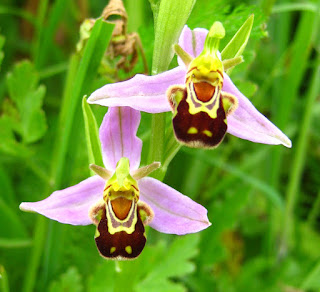Bee Orchid seeds
Sowing time for wildflowers is all year round with
best results sowing either March to early May, or from August to September.
Ophrys apifera is an attractive orchid with several small flowers, each of which has a lip resembling a bee, and three large, pink, petal-like outer sepals; the two other inner sepals look like antennae. The whole flower thus mimics an insect feeding on a flower. In biology, the term ‘mimicry’ refers to cases where natural selection has favoured a resemblance between individuals of different species, and there are numerous examples of orchid flowers which resemble their insect pollinators.
In other Ophrys species in the Mediterranean region, for example, male bees or wasps try to copulate with the lip of the flowers, which look and smell like the females of their own species. However, in Britain and generally elsewhere, the bee orchid, is self-pollinated and the pollinia, which hang on a thread, are blown against the receptive surface of the stigma.
People who have never seen a bee orchid in the wild have a treat in store. Each flower is perfection in miniature. Colour is provided by three prominent, triangular sepals in a rich blancmange pink. But it is the lowest of three petals where the action takes place, for this is enlarged into a lip, and to my mind has all the appearances of a tiny velveteen boxing glove. To others this lip looks more like a bee foraging at the heart of a pink flower: bees obviously think the same, for the lip has evolved with the one purpose of attracting horny male bees, who pollinate the flowers in their unsatisfied attempts to mate with this furry vegetable protuberance. The whole process is known, somewhat charmlessly, as pseudocopulation.
The stems are up to 50 cm tall, with usually around six (but up to 14) flowers. The sepals are pink or whitish and are 12–16 mm long. The petals are narrow, green or purplish, velvety and 5 mm long. The lip is three-lobed. The lateral lobes form hairy cones. The middle lobe is pointed and bent backwards to form the rounded body of the ‘bee’, and is brown with a dark, angular u-shape outlined in yellow.
In reality, the bee orchid is the one member of the genus Ophrys that has largely given up relying on bees to effect pollination, but instead has evolved to do it all by itself through self-pollination. The two pollen masses – pollinia - are held side by side and in an upright position immediately below the strange bird's head structure that projects above the lip. Their filaments are thin and feeble, so as the flowering season progresses, gravity invariably drags the pollinia out of their protective sheaths so that they dangle limply, in the manner of a de-socketed eyeball in some ghoulish zombie flick. It's then only a matter of time before wind or the jolt of a passing animal swings the pollinia onto the sticky and receptive stigma behind. In practical terms, what this means is that bee orchids set plenty of seed pods producing copious seed. For this reason, bee orchids are one of our commonest species, colonising far and wide (at least across much of England – they are highly localised in Wales and largely absent from Scotland).












No comments:
Post a Comment